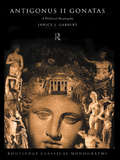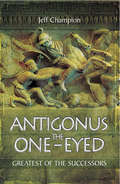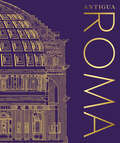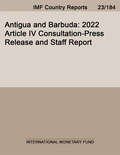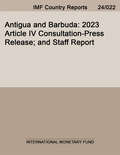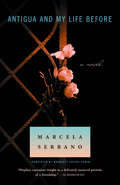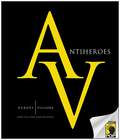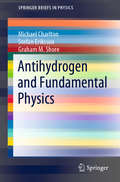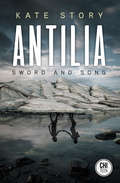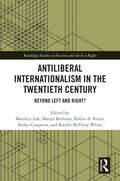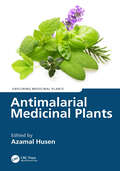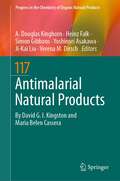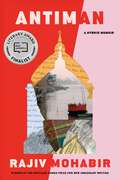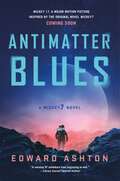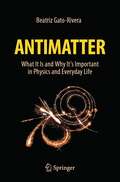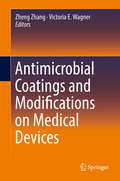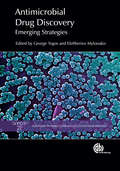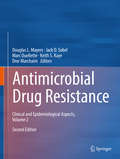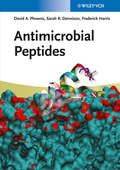- Table View
- List View
Antigonus II Gonatas: A Political Biography
by Janice J. GabbertFirst Published in 2004. Routledge is an imprint of Taylor & Francis, an informa company.
Antigonus the One-Eyed: Greatest of the Successors
by Jeff ChampionThe author of Pyrrhus of Epirus &“tells the exciting story of one of those competing to succeed Alexander the Great . . . Recommended.&” —Firetrench Plutarch described Antigonus the One Eyed (382-301 BC) as &“the oldest and greatest of Alexander&’s successors.&” Antigonus loyally served both Philip II and Alexander the Great as they converted his native Macedonia into an empire stretching from India to Greece. After Alexander&’s death, Antigonus, then governor of the obscure province of Phrygia, seemed one of the least likely of his commanders to seize the dead king&’s inheritance. Yet within eight years of the king&’s passing, through a combination of military skill and political shrewdness, he had conquered the Asian portion of the empire. Antigonus&’ success caused those who controlled the European and Egyptian parts of the empire to unite against him. For another fourteen years he would wage war against a coalition of the other Successors, Ptolemy, Lysimachus, Seleucus and Cassander. In 301 he would meet defeat and death in the Battle of Ipsus. The ancient writers saw Antigonus&’ life as a cautionary tale about the dangers of hubris and vaulting ambition. Despite his apparent defeat, his descendants would continue to rule as kings and create a dynasty that would rule Macedonia for over a century. Jeff Champion narrates the career of this titanic figure with the focus squarely on the military aspects. &“It is far time that we have a biography of one of the greatest men of Hellenistic society . . . His rise from this backwater to almost becoming the king of the entire Macedonian empire is detailed by the author.&”—A Wargamers Needful Things.
Antigua Roma (Ancient Rome)
by DKSumérgete en la historia de la Antigua Roma, desde sus orígenes en un pequeño asentamiento en el monte Palatino hasta su apogeo como imperio de más de 90 millones de personas y su tumultuoso declive.Cubriendo más de 1,000 años de historia, 'Antigua Roma' revela con todo detalle los eventos políticos, culturales y militares clave que dieron forma al Imperio Romano y explora cómo era vivir en una sociedad que sentó las bases de nuestro mundo moderno.La suntuosa fotografía y los textos fiables y atractivos cubren cada faceta de la vida de la antigua Roma, desde el arte, la filosofía y el entretenimiento hasta la ingeniería, la medicina y la guerra, mientras que los mapas detallados trazan el ascenso del poderoso Imperio Romano.Con biografías detalladas de los más grandes emperadores de Roma, desde Augusto hasta Constantino, así como de otras figuras clave (generales, filósofos y escritores), 'Antigua Roma' profundiza también en las fascinantes historias de gladiadores, panaderos y esclavos. Las calles y los edificios de Roma cobran vida con recreaciones digitales especialmente creadas para este libro, mientras que acontecimientos trascendentales como la destrucción de Pompeya se relatan con la ayuda de ilustraciones, artefactos y testimonios visuales.Bellamente ilustrado y de un alcance incomparable, 'Antigua Roma' es el libro perfecto para cualquier persona interesada en este período decisivo de la historia mundial.Immerse yourself in the history of Ancient Rome - from its origins as a small settlement on the Palatine Hill to its peak as an empire reigning over 90 million people, and its tumultuous decline.Covering more than 1,000 years of history, 'Antigua Roma'reveals in vivid detail all the key political, cultural, and military events that shaped the Roman Empire and explores what it was like to live in a society that laid the foundations for our modern world.Sumptuous photography and authoritative, engaging text cover every facet of life in ancient Rome, from art, philosophy, and entertainment to engineering, medicine, and war, while detailed maps trace the rise of the mighty Roman Empire.Featuring in-depth biographies of Rome's greatest emperors, from Augustus to Constantine, as well as key figures such as generals, philosophers, and writers, 'Antigua Roma' also delves into the fascinating stories of gladiators, bakers, and enslaved people. The streets and buildings of Rome are brought to life with specially commissioned CGI recreations, while momentous events such as the destruction of Pompeii are told with the help of illustrations, artifacts, and eyewitness accounts.Beautifully illustrated and unparalleled in scope, 'Antigua Roma' is the perfect book for anyone who is interested in this defining period of world history.
Antigua and Barbuda: 2022 Article IV Consultation-Press Release and Staff Report
by International Monetary Fund. Western Hemisphere Dept.A report from the International Monetary Fund.
Antigua and Barbuda: 2023 Article Iv Consultation-press Release; And Staff Report (Imf Staff Country Reports)
by International Monetary Fund. Western Hemisphere Dept.A report from the International Monetary Fund.
Antigua and My Life Before: A Novel
by Margaret Sayers Peden Marcella SerranoJosefa Ferrer, a famous Chilean singer and star, awakens one morning to read in the Santiago newspaper that her best friend, Violeta, has been involved in a brutal act of violence. Overwhelmed with regret and plagued with guilt for not having foreseen the tragedy, Josefa feels compelled to tell Violeta's life story--one marked by lost ideals, disillusionment, and grief--which is ultimately Josefa's story, too. Through the interwoven lives of these two women, Marcela Serrano explores how the demands of a woman's role as mother, wife, lover, and friend are frequently at odds with her own dreams and aspirations, and how easily the fragile bonds of friendship and family can be strained to the breaking point. For Josefa and Violeta, it is only in Antigua, under the watchful eyes of "the others"--a chorus of female ancestral spirits who testify to the women's defining moments of strength and courage--that Josefa and Violeta will discover that even in the aftermath of violence and betrayal they have control over their destinies and their redemption. Exquisitely crafted and written in beautiful, lyrical prose, Marcela Serrano's unforgettable novel about friendship, forgiveness, and second chances speaks to every woman who has experienced the wrenching divide between professional ambition and family responsibility, who has been torn between the excitement of illicit passion and the security of marriage, who has craved the thrill of success while yearning for solitude in an often chaotic, invasive world.
Antiheroes: Heroes, Villains, and the Fine Line Between
by Jennifer Crusie Adam-Troy Castro Mary BorsellinoThe most interesting characters are almost never the good guys. Doing the right thing is great and all, but a little bit of darkness—or a lot of it—often makes for a more engaging story. Antiheroes: Heroes, Villains, and the Fine Line Between is dedicated to the dark heroes and sympathetic villains we love. Find out why William McKinley High's agonist Sue Sylvester is essential to Glee. Discover where your favorite comic book character falls on the continuum of good and evil. Weigh in on Twilight's very dangerous boy Edward Cullen: romantic, sparkly hero, or sociopath suffering from Antisocial Personality Disorder? Plus other essays on: The Vampire Diaries' most antiheroic antihero, Damon Salvatore America's favorite serial killer, Dexter Morgan, and the nature (and nurture) of evil The curious appeal of Alias' Arvin Sloane Supernatural's vampire hunter-cum-vampire Gordon Walker The shared monstrosity of Spider-Man, Doc Ock, and the Green Goblin Gun-slinging necromancer Anita Blake, and the benefits (and pitfalls) of embracing the monster within This brand new, e-book only collection of essays—"remixed" from previous Smart Pop series titles—gives a funny and thought-provoking in-depth look at the antihero, from the villains just a little too good to be unequivocal bad guys, and the heroes just a bit too bad to be truly good.
Antihydrogen and Fundamental Physics: Testing Fundamental Physics (SpringerBriefs in Physics)
by Michael Charlton Stefan Eriksson Graham M. ShoreThe advent of high-precision antihydrogen spectroscopy has opened up the possibility of direct tests with unprecedented accuracy of some of the most fundamental principles of physics, notably Lorentz and CPT symmetry and the Einstein equivalence principle.This book reviews these principles, emphasising their interconnections in quantum field theory and general relativity and the special role of antimatter, and explores how they may be tested in current and forthcoming experiments on antihydrogen. Original research results relevant to the experimental programme of the ALPHA collaboration at CERN are presented, together with the implications for antihydrogen of proposed theories featuring novel `fifth-force' interactions.
Antilia: Sword and Song
by Kate Story“An utterly contemporary, exquisitely imagined parallel-world fantasy with a deeply satisfying plot and unforgettable characters” (Holly Bennett, author of Redwing). It’s the near future, and the world is on the brink of war. The paths of two lonely teens converge, caught in an uncontrollable current crashing through time and space. Rowan and Ophelia discover they share a place that’s the stuff of childhood dreams. In Antilia there is magic, and humans walk alongside minor gods and mythological beings. But all is not what it seems, and the two are pulled inexorably into a divided realm. Separated and unable to get home, they find Antilia and Earth’s fate are forged together. Can Ophelia and Rowan repair the damage, fulfill their destinies, and save both worlds from annihilation? Antilia: Sword and Song is an epic story of survival and self-discovery. “You know a good book as soon as you start it. It sings to you and makes an immediate connection. That’s what happened to me with Kate Story’s Antilia. I loved everything about the book.” —Charles de Lint, World Fantasy Award–winning author
Antiliberal Internationalism in the Twentieth Century: Beyond Left and Right? (Routledge Studies in Fascism and the Far Right)
by Stefan Couperus Matthijs Lok Marjet Brolsma Robin De Bruin Rachel McElroy WhiteThis book shows how antiliberal discourse, thought, and mobilization have, in defiance of nationalist aims, been significantly shaped and determined in the international sphere, as new collaborations position themselves against the liberal order established after the fall of the Berlin Wall.Despite often drawing inspiration from nationalist movements and ideologies, antiliberalism is a phenomenon that transcends domestic contexts and settings in important ways. This collection of essays charts the many-sided aspects of twentieth-century internationalism and its contemporary developments across the globe. Without excluding well-known European sources of antiliberal internationalism, it decentres the European experience by exploring specific case studies from South and East Asia, the Middle East, the Americas, Africa, and Oceania. Moreover, the volume abundantly demonstrates that “liberalism” and “anti-liberalism” cannot be considered as fixed entities as (anti)liberalism was, and is, as much defined by its enemies as by its advocates.This book is intended for scholars and students of International Studies, Intellectual History, Political History, Political Science, European Studies, and Global Studies, as well as for journalists and policymakers interested in contemporary Europe, cosmopolitanism, political polarization, and the traditions of the right and far right.
Antillia (The Backwaters Prize in Poetry Honorable Mention)
by Henrietta GoodmanWinner of the Backwaters Prize in Poetry Honorable Mention The title poem of this collection refers to the phantom island of Antillia, included on maps in the fifteenth century but later found not to exist. The ghosts that haunt this collection are phantom islands, moon lakes, lasers used to clean the caryatids at the Acropolis, earlier versions of the self, suicides, a madam from the Old West, petroleum, snapdragons, pets, ice apples, Casper, and a &“resident ghost&” who makes the domestic realm of &“the cradle and the bed&” uninhabitable. The ghosts are sons, fathers &“asleep in front of the TV,&” and a variety of exes—&“lost boys&” with names like The Texan and Mr. No More Cowboy Hat whom Henrietta Goodman treats with snarky wit but also with grief, guilt, and love. Although memories pervade this collection, these poems also look forward and outward into a world where social inequality and environmental disaster meet the possibility of metamorphosis.
Antimalarial Medicinal Plants (Exploring Medicinal Plants)
by Azamal HusenMalaria continues to affect a large population of the world, especially in third world countries. The spread of drug-resistant parasites demonstrates the need for antimalarial agents with various modes of action. The search for remedies derived from medicinal plants for the treatment of malaria is reliant on accurate ethnobotanical and ethnopharmacological information obtained from traditional medical practitioners. Antimalarial Medicinal Plants provides information on bioactive compounds and therapeutic potentials of several antimalarial plant species found around the globe. This book evaluates these plant species with respect to their biology, diversity, distribution, and pharmacological values.A volume in the Exploring Medicinal Plants series, this book highlights trends, technologies, processes, and services important to and necessary for efficient production, use, and understanding of medicinal qualities of antimalarial plants. It critically examines claims made by traditional medical practitioners with scientific validations for safe herbal drug formulation. It is a reference work for researchers of herbal medicine, traditional healers, pharmacists, and students associated with plant sciences and economic botany.
Antimalarial Natural Products (Progress in the Chemistry of Organic Natural Products #117)
by A. Douglas Kinghorn Heinz Falk Simon Gibbons Yoshinori Asakawa Ji-Kai Liu Verena M. DirschThis volume begins with a short history of malaria and follows with a summary of its biology. It then traces the fascinating history of the discovery of quinine for malaria treatment, and then describes quinine’s biosynthesis, its mechanism of action, and its clinical use, concluding with a discussion of synthetic antimalarial agents based on quinine’s structure. It also covers the discovery of artemisinin and its development as the source of the most effective current antimalarial drug, including summaries of its synthesis and biosynthesis, its mechanism of action, and its clinical use and resistance. A short discussion of other clinically used antimalarial natural products leads to a detailed treatment of additional natural products with significant antiplasmodial activity, classified by compound type. Although the search for new antimalarial natural products from Nature’s combinatorial library is challenging, it is very likely to yield new antimalarial drugs. This book thus ends by identifying ten natural products with development potential as clinical antimalarial agents.
Antiman: A Hybrid Memoir
by Rajiv MohabirWinner of the Restless Books Prize for New Immigrant Writing, Rajiv Mohabir’s Antiman is an impassioned, genre-blending memoir that navigates the fraught constellations of race, sexuality, and cultural heritage that have shaped his experiences as an Indo-Guyanese queer poet and immigrant to the United States. <p><p> Growing up a Guyanese Indian immigrant in Central Florida, Rajiv Mohabir is fascinated by his family’s abandoned Hindu history and the legacy of his ancestors, who were indentured laborers on British sugarcane plantations. In Toronto he sits at the feet of Aji, his grandmother, listening to her stories and songs in her Caribbean Bhojpuri. By now Aji’s eleven children have immigrated to North America and busied themselves with ascension, Christianity, and the erasure of their heritage and Caribbean accents. But Rajiv wants to know more: where did he come from, and why does he feel so out of place? <p><p> Embarking on a journey of discovery, he lives for a year in Varanasi, on the banks of the Ganges, perfecting his Hindi and Bhojpuri and tracing the lineage of his Aji’s music. Returning to Florida, the cognitive dissonance of confederate flags, Islamophobia, and his father’s disapproval sends him to New York, where finds community among like-minded brown activists, work as an ESL teacher, and intoxication in the queer nightlife scene. But even in the South Asian paradise of Jackson Heights, Rajiv feels like an outsider: “Coolie” rather than Desi. And then the final hammer of estrangement falls when his cousin outs him as an “antiman”—a Caribbean slur for men who love men—and his father and aunts disown him. <p><p> But Aji has taught Rajiv resilience. Emerging from the chrysalis of his ancestral poetics into a new life, he embraces his identity as a poet and reclaims his status as an antiman—forging a new way of being entirely his own. Rapturous, inventive, and devastating in its critique of our own failures of inclusion, Antiman is a hybrid memoir that helps us see ourselves and relationships anew, and announces an exciting new talent in Rajiv Mohabir.
Antimatter (Deep Space Nine #8)
by John VornholtThe Bajoran shipyard is assigned to build an engine for a new starship, a project which could be instrumental in revitalizing the planet's war-ravished economy. As Commander Sisko awaits the arrival of a tanker containing the antimatter that will power the starship, a band of hijackers captures the extremely valuable cargo and escapes through the wormhole. When the hijacking spurs a political debate, Major Kira struggles to mediate the dispute between the opposing factions. Meanwhile, Sisko makes a desperate move to retrieve the antimatter. With the stability of the Bajoran economy at stake, Sisko, Dax, and Odo infiltrate the hijackers, a move that could have deadly consequences for them and the planet Bajor.
Antimatter Blues: A Mickey7 Novel (Mickey7 #2)
by Edward AshtonEdward Ashton's Antimatter Blues is the thrilling follow up to Mickey7 in which an expendable heads out to explore new terrain for human habitation.Summer has come to Niflheim. The lichens are growing, the six-winged bat-things are chirping, and much to his own surprise, Mickey Barnes is still alive—that last part thanks almost entirely to the fact that Commander Marshall believes that the colony’s creeper neighbors are holding an antimatter bomb, and that Mickey is the only one who’s keeping them from using it. Mickey’s just another colonist now. Instead of cleaning out the reactor core, he spends his time these days cleaning out the rabbit hutches. It’s not a bad life.It’s not going to last.It may be sunny now, but winter is coming. The antimatter that fuels the colony is running low, and Marshall wants his bomb back. If Mickey agrees to retrieve it, he’ll be giving up the only thing that’s kept his head off of the chopping block. If he refuses, he might doom the entire colony. Meanwhile, the creepers have their own worries, and they’re not going to surrender the bomb without getting something in return. Once again, Mickey finds the fate of two species resting in his hands. If something goes wrong this time, though, he won’t be coming back.
Antimatter: What It Is and Why It's Important in Physics and Everyday Life
by Beatriz Gato-RiveraAntimatter is one of the most fascinating aspects of Particle Physics, and matter-antimatter annihilation the most energetic process in the universe. If they existed, everyday objects made of antimatter would look exactly like those made of ordinary matter, as would antimatter stars. We live surrounded by antimatter, since showers of matter and antimatter particles fall incessantly on the Earth's surface, some of them penetrating our buildings. Furthermore, many things around us - bananas, for example - actually emit antielectrons.This book first introduces the essentials of particle physics and the nature of particles and antiparticles. It describes the discovery of antimatter particles and explains how they are produced, where they are found, and how antistars could be spotted; it also introduces cosmic rays, particle accelerators, dark matter, dark energy and nuclear reactions in stars. The enigma of the matter-antimatter asymmetry in the Universe is discussed as are the very real applications of antimatter in hospitals, in industry and in cutting-edge research and technology, Non-specialist readers will find here a wealth of fascinating and accessible information to deepen their appreciation of antimatter.
Antimercantilism in Late Medieval English Literature
by Roger A. LaddThis study explores the relationship between ideology and subjectivity in late medieval literature, documenting the trajectory of antimercantile ideology against major developments in economic theory and practice in the later Middle Ages.
Antimicrobial Coatings and Modifications on Medical Devices
by Zheng Zhang Victoria E. WagnerBased on a fundamental understanding of the interaction between bacteria and materials, this timely volume emphasizes the latest research in the antimicrobial interfacial design and provides an invaluable blueprint for improving antimicrobial performance on devices and products. Antimicrobial Coatings and Modifications targets reduction of microbial accumulation on biomedical and industrial materials through changing interfacial characteristics. Applying a viable antimicrobial coating or modification to resist alarming threats is a highly demanding requirement for many medical and engineering applications. Many contemporary books in the area of antimicrobial solution focus on applying antimicrobial agents or materials that can kill bacteria. The volume pays more attention to eliminating bacterial contamination and biofilm formation through surface characteristics with minimized bacterial resistance and environmental impact.
Antimicrobial Compounds: Current Strategies and New Alternatives
by Tomás G. Villa Patricia Veiga-CrespoSince penicillin and salvarsan were discovered, a number of new drugs to combat infectious diseases have been developed, but at the same time, the number of multi-resistant microorganism strains is increasing. Thus, the design of new and effective antibacterial, antiviral and antifungal agents will be a major challenge in the next years. This book reviews the current state-of-the-art in antimicrobial research and discusses new strategies for the design and discovery of novel therapies. Topics covered include the use of genetic engineering, genome mining, manipulation of gene clusters, X-ray and neutron scattering as well as the antimicrobial effects of essential oils, antimicrobial agents of plant origin, beta-lactam antibiotics, antimicrobial peptides, and cell-wall-affecting antifungal antibiotics.
Antimicrobial Drug Discovery
by Eleftherios Mylonakis George Tegos Eliora Ron Arnold Demain Hattie GreshamDrug resistance is increasing among a variety of human pathogenic microorganisms such as Enterococcus faecium, Staphylococcus aureus, Klebsiella pneumoniae, Acinetobacter baumaniii, Pseudomonas aeruginosa and Enterobacter spp. (currently dubbed the 'ESKAPE' pathogens), and has emerged as one of the most important clinical challenges of this century. Increased general awareness and fear of these pathogens means there is a growing demand for research to tackle the threat of multidrug resistance. Documenting the latest research in the field, this book discusses current and promising activities to discover new antimicrobials in five key areas: molecular genetics and systems microbiology; synthetic, computational chemistry and chemoinformatics; High Throughput Screening (HTS); non-vertebrate model hosts; and light- and nano-based technologies.
Antimicrobial Drug Resistance: Clinical and Epidemiological Aspects, Volume 2 (Infectious Disease Ser.)
by Jack D. Sobel Douglas L. Mayers Marc Ouellette Keith S. Kaye Dror MarchaimThe two volumes included in Antimicrobial Drug Resistance, Second Edition is an updated, comprehensive and multidisciplinary reference covering the area of antimicrobial drug resistance in bacteria, fungi, viruses, and parasites from basic science, clinical, and epidemiological perspectives. This newly revised compendium reviews the most current research and development on drug resistance while still providing the information in the accessible format of the first edition. The first volume, Antimicrobial Drug Resistance: Mechanisms of Drug Resistance, is dedicated to the biological basis of drug resistance and effective avenues for drug development. With the emergence of more drug-resistant organisms, the approach to dealing with the drug resistance problem must include the research of different aspects of the mechanisms of bacterial resistance and the dissemination of resistance genes as well as research utilizing new genomic information. These approaches will permit the design of novel strategies to develop new antibiotics and preserve the effectiveness of those currently available. The second volume, Antimicrobial Drug Resistance: Clinical and Epidemiological Aspects, is devoted to the clinical aspects of drug resistance. Although there is evidence that restricted use of a specific antibiotic can be followed by a decrease in drug resistance to that agent, drug resistance control is not easily achieved. Thus, the infectious diseases physician requires input from the clinical microbiologist, antimicrobial stewardship personnel, and infection control specialist to make informed choices for the effective management of various strains of drug-resistant pathogens in individual patients. This 2-volume set is an important reference for students in microbiology, infectious diseases physicians, medical students, basic scientists, drug development researchers, microbiologists, epidemiologists, and public health practitioners.
Antimicrobial Drug Resistance: Mechanisms of Drug Resistance, Volume 1 (Infectious Disease Ser.)
by Jack D. Sobel Douglas L. Mayers Marc Ouellette Keith S. Kaye Dror MarchaimThe two volumes included in Antimicrobial Drug Resistance, Second Edition is an updated, comprehensive and multidisciplinary reference covering the area of antimicrobial drug resistance in bacteria, fungi, viruses, and parasites from basic science, clinical, and epidemiological perspectives. This newly revised compendium reviews the most current research and development on drug resistance while still providing the information in the accessible format of the first edition. The first volume, Antimicrobial Drug Resistance: Mechanisms of Drug Resistance, is dedicated to the biological basis of drug resistance and effective avenues for drug development. With the emergence of more drug-resistant organisms, the approach to dealing with the drug resistance problem must include the research of different aspects of the mechanisms of bacterial resistance and the dissemination of resistance genes as well as research utilizing new genomic information. These approaches will permit the design of novel strategies to develop new antibiotics and preserve the effectiveness of those currently available. The second volume, Antimicrobial Drug Resistance: Clinical and Epidemiological Aspects, is devoted to the clinical aspects of drug resistance. Although there is evidence that restricted use of a specific antibiotic can be followed by a decrease in drug resistance to that agent, drug resistance control is not easily achieved. Thus, the infectious diseases physician requires input from the clinical microbiologist, antimicrobial stewardship personnel, and infection control specialist to make informed choices for the effective management of various strains of drug-resistant pathogens in individual patients. This 2-volume set is an important reference for students in microbiology, infectious diseases physicians, medical students, basic scientists, drug development researchers, microbiologists, epidemiologists, and public health practitioners.
Antimicrobial Materials and Interfaces: Synthesis, Characterization, and Applications
by Peng Li En-Tang Kang Liqun XuA review of novel antimicrobial materials remedies for eradication of common and multidrug-resistant bacteria Antimicrobial Materials and Interfaces covers a wide range of antimicrobial materials with a review of the synthesis, characterization, and applications of each material. Contributed to by leading experts in the field, Antimicrobial Materials and Interfaces includes information on: Cationic and zwitterionic polymers-based antimicrobial materials, zwitterionic polymers as antifouling materials, and superhydrophobic antifouling and antimicrobial materialsAntimicrobial peptides, protease antibacterial materials, antimicrobial nanometallics, and antimicrobial metal and covalent organic frameworksOne- and two-dimensional, photothermal, photodynamic, stimuli-responsive, and intelligent antimicrobial materialsNitric oxide delivery materials, sonodynamic sterilization materials, and polymer-based antibacterial ureteral stentsPiezoelectric and photocatalytic materials for antibacterial therapy and microneedle technology for the management of bacterial skin infections Antimicrobial Materials and Interfaces is an essential reference on promising novel materials for materials scientists and inorganic, bioinorganic, medicinal, polymer, and protein chemists.
Antimicrobial Peptides
by David A. Phoenix Frederick Harris Sarah R. DennisonIn this text, the small team of expert authors presents the field in a comprehensive and accessible manner that is well suited for students and junior researchers.The result is a highly readable and systematically structured introduction to antimicrobial peptides, their structure, biological function and mode of action. The authors point the way towards a rational design of this potentially highly effective new class of clinical antibiotics on the brink of industrial application. They do this by discussing their design principles, target membranes and structure-activity relationships. The final part of the book describes recent successes in the application of peptides as anticancer agents.
